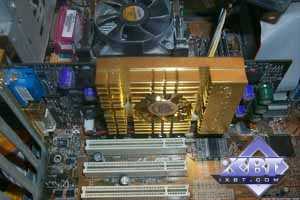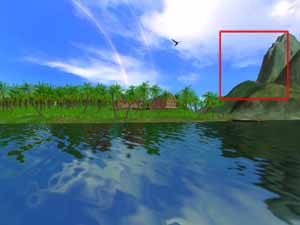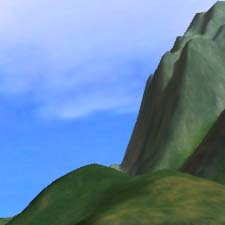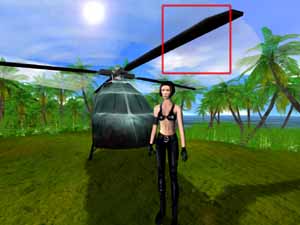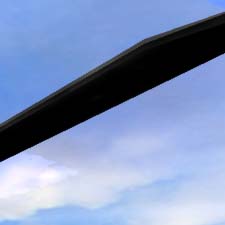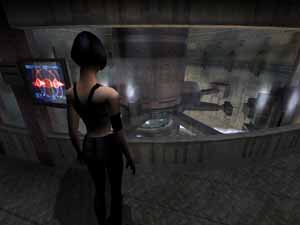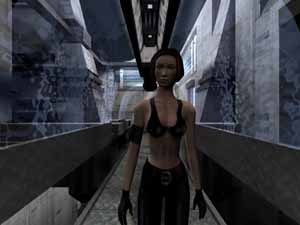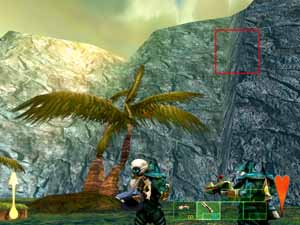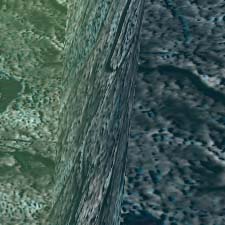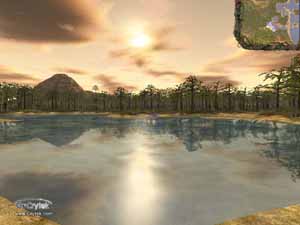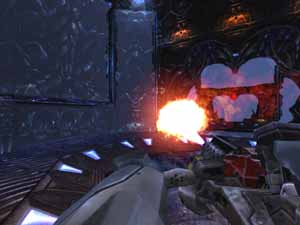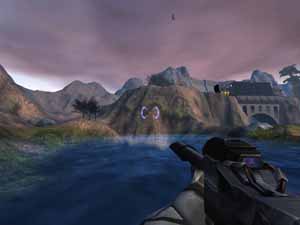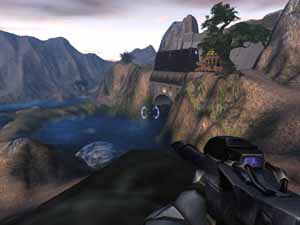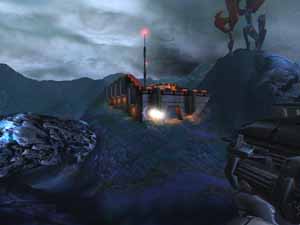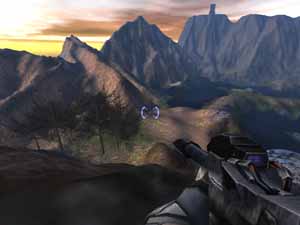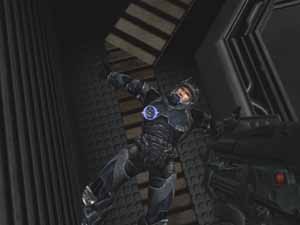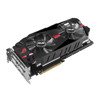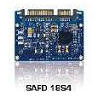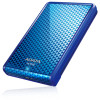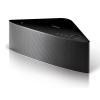This chip is presented by Chaintech A-G321 GeForce3 Ti200 SE 128MB, AGP videocard.
Features:
- NVIDIA GeForce3, 175 MHz clock rate;
- 128MB DDR SDRAM memory in eight Samsung 4ns microchips, 200 (400) MHz clock rate, 128-bit bus;
- Peak fill rate in the multitexturing mode without optimizations is 700 megapixels/sec and 1400 megatexels/sec.
Wasn't overclocked.
The end of April 2001 brought the new NVIDIA product, fundamentally differing from all previous solutions by memory optimizations. It's known that memory bandwidth was the most vulnerable part of all recent accelerators. New cards required faster and more expensive memory, resulting in increased prices. GeForce2 Ultra with 64MB of the most expensive 4ns memory has become the peak. The incredible prices and sales failure of these cards taught NVIDIA a lesson and the company tried hard to consider all previous mistakes in the new product. It's interesting that GeForce3 had memory with the same clock rate (230 (460) MHz) as GeForce2 Ultra, but the core clock rate was even lower (200 MHz vs. 250 MHz). This resulted in undoubtful victory of GeForce3 in 32-bit color mode, and GeForce2 Ultra was only the second lacking memory bandwidth. GeForce3 cards were the industry leaders (in the 3D accelerators sector) until the fall of 2001. The September Ti200/500 line put an end to the life of the February firstling. Such a short life of the top product.
Now GeForce3 Ti200/500 is on the homestretch. The release of GeForce4 Ti, actually being the improved GeForce3, passed the sentence on the previous family. If GeForce4 MX strikes GeForce2 line, then GeForce4 Ti is aimed at GeForce3 Ti200/500, at Ti500 in particular. The destiny of Ti200 is still unknown. First, it's a very profitable product for manufacturers, and they'll try hard to prolong its life. Second, it's profitable for NVIDIA only coupled with Ti500 (as wastes of Ti500 are used to make Ti200), so the termination of Ti500 production will mean the death of Ti200, and despite the perfomance of GeForce4 MX460, being the mainstream top model, is on the level of Ti200, the former lacks some capabilities of the latter, pixel shaders in particular. So if ATI reduces prices for its RADEON 8500 line, it would be hard for pared-down GeForce4 MX460 to survive. But Ti 4200 is already on it's way to save the GeForce4 family...
But before the death of Ti 200 some companies have decided to promote these cards further and started equipping them with 128MB of the same memory instead of 64MB. Our review of these cards has shown that for now such memory size remains undemanded though there are games to come into the picture that can use it. It's good that prices for such cards are not much higher than those of 64MB ones.
On the 10th of July 2002 the latest drivers from NVIDIA are 29.80, 30.30 for Windows XP.
You can see perfomance readouts of this card in the summary diagrams.
And now I want to attract your attention to another important 3D feature - filtering. As many of you know, all chipsets support bilinear filtering that is an important instrument in MIP-mapping, some chipsets support trilinear filtering (true, not the approximation) and only few support anisotropic filtering.
Due to the fact that GeForce2 and GeForce3 do support anisotropic filtering, I recommend you to pay attention to the article concerning this feature.
I shall mark that GeForce3 supports new types of antialiasing based on multisampling
(MSAA) technology, including noteworthy Quincunx mode (read about it in our GeForce3).
Here are two examples:
Interesting technologies of working with vertex and pixel shaders allow to get more realistic lighting effects and to form original solutions like semi-transparent objects on the right screenshot:
As far back as 1999 Matrox released a revolutionary (for those years) technology of relief texturing with usage of environment maps - EMBM. Time passed and some other Bump Mapping technologies began to spread (though slowly), and DOT3 most of all. But however developers didn't like such effective methods of realistic representation of complex 3D objects that had not so smooth surface in the majority of cases. The reason of this attitude was a very small number of graphic accelerators capable of working with Bump Mapping of mentioned types. By the way there's also the Emboss BM, supported by almost all cards, but due to low 3D-realism and high resources requirements it hasn't become widespread. Only after releases of NVIDIA GeForce and especially GeForce2 some mediocre realizations of BM began to appear, namely DOT3. EMBM begins to spread as well because not only Matrox G400, but also ATI RADEON and NVIDIA GeForce3 support it now. The example of EMBM can be seen on the water surface screenshot above. Giants game has become a good example of BM:
Bump Mapping DOT3 is widely used in this game and EMBM is used occasionally. I hope EMBM application would become wider than it has been before. I shall add that a new version of this game, using GeForce3 features, is included into ELSA Gladiac 920 box. Read more about it in the ELSA Gladiac 920 review.
The power and perfomance of GeForce3 is in the best way demonstrated in the demo-version of the future X-Isle - Dinosaur Island game:
If some are not satisfied with these (as many think X-Isle is just a techno demo), here you are: the screenshots from the future Unreal2 hit (they were taken from the alpha version, and may developers forgive me for using stolen pictures, but the WWW is full of this alpha stuff)!
There's no criticism about 3D quality in all the games tested. Look at the shots taken on this card.
| Games / Cards | 1 | 2 | 3 | 4 | 5 | 6 | 7 | 8 | 9 | 10 | 11 | 12 |
| NVIDIA GeForce3 |
| Games / Cards | 13 | 14 | 15 | 16 | 17 | 18 | 19 | 20 | 21 | 22 | 23 | 24 |
| NVIDIA GeForce3 |
| Games / Cards | 25 | 26 | 27 | 28 | 29 | 30 |
| NVIDIA GeForce3 |
Game list:
- 1. Return to Castle Wolfenstein
- 2. Unreal2 (alpha version)
- 3. Comanche4
- 4. Jedi Knight II Outcast
- 5. Morrowind
- 6. Colin McRAE Rally2
- 7. Red Faction
- 8. Rally Trophy
- 9. Sacrifice
- 10. Venom
- 11. Unreal Tournament 2003 DEMO
- 12. Real MYST
- 13. Blade of Darkness
- 14. Neverwinter Nights
- 15. 3DMark2001: Game1
- 16. 3DMark2001: Game2
- 17. 3DMark2001: Game3
- 18. 3DMark2001: Game4
- 19. 3DMark2001: Dot3
- 20. 3DMark2001: EMBM
- 21. 3DMark2001: Vertex Shaders
- 22. 3DMark2001: Pixel Shaders
- 23. Warcraft III
- 24. Soldier of Fortune II
- 25. Command and Conquer: Renegade
- 26. Max Payne
- 27. AquaNox
- 28. Serious Sam: The Second Encounter
- 29. IL2: Shturmovik
- 30. MoHAA
And 10.* and newer drivers are not compatible with older software for sound
cards based on Yamaha processor, as well as with SoftXG100 software synthesizer.
Start or Close Window buttons might be spoiled by some "garbage" in 2D mode. One
solution is in the iXBT forum.
